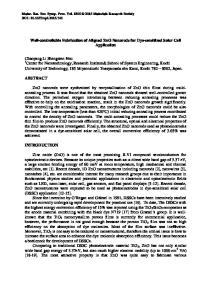Strong Red Luminescent Twin ZnO Nanorods for Nano-thermometry Application
- PDF / 715,853 Bytes
- 7 Pages / 432 x 648 pts Page_size
- 2 Downloads / 338 Views
Advances:
Email alerts: Click here Subscriptions: Click here Commercial reprints: Click here Terms of use : Click here
Strong Red Luminescent Twin ZnO Nanorods for Nano-thermometry Application Avanendra Singh, Kartik Senapati, Karuna Kar Nanda and Pratap K. Sahoo MRS Advances / Volume 1 / Issue 13 / January 2016, pp 869 - 874 DOI: 10.1557/adv.2016.162, Published online: 24 February 2016
Link to this article: http://journals.cambridge.org/abstract_S2059852116001626 How to cite this article: Avanendra Singh, Kartik Senapati, Karuna Kar Nanda and Pratap K. Sahoo (2016). Strong Red Luminescent Twin ZnO Nanorods for Nano-thermometry Application. MRS Advances, 1, pp 869-874 doi:10.1557/adv.2016.162 Request Permissions : Click here
Downloaded from http://journals.cambridge.org/ADV, IP address: 207.162.240.147 on 19 Aug 2016
MRS Advances © 2016 Materials Research Society DOI: 10.1557/adv.2016.162
Strong Red Luminescent Twin ZnO Nanorods for Nano-thermometry Application Avanendra Singh1, Kartik Senapati1, Karuna Kar Nanda2, and Pratap K. Sahoo1* 1 School of Physical Sciences, National Institute of Science Education and Research (NISER) Bhubaneswar, Odisha-751005, India 2 Materials Research Centre, Indian Institute of Science, Bangalore-560012, India *[email protected]
ABSTRACT Two segments of horizontally grown crystalline ZnO nanorods (NRs) connected with an amorphous layer have been successfully and reproducibly synthesized using one-step hydrothermal technique by controlling the growth rate. The confocal photoluminescence (PL) imaging and spectroscopy of twin ZnO NRs at different temperatures shows intense red emission with comparably week UV emission. The strong red emission from the twin NRs is a consequence of structural imperfections. Both UV and red bands showed signatures of strong temperature dependent exciton-phonon scattering. Using the intensity ratio of the UV and red emissions, we show that the individual ZnO NRs can be used as highly sensitive cryogenic temperature sensors below ~175 K. INTRODUCTION Among the wide variety of low-dimensional semiconductor nanostructures, Zinc Oxide (ZnO) nanorods (NRs) are promising for short-wavelength optoelectronic Nano-device and photonic applications [1-3]. The intrinsic properties like direct wide band gap of ~3.4eV and large exciton binding energy (60 meV) made ZnO a promising candidate for UV emitting stimulated emission at room temperature [4]. Depending on the synthesis method and doping it possesses a large number of intrinsic deep-level impurities and complexes that emits light with tunable colors [5]. Due to in-built polarity in the crystal structure of ZnO, the Fröhlich interaction becomes stronger, which leads to frequent decay of free excitons via one or more longitudinal optical (LO) phonon modes [6-11]. Recently we have proposed the phonon tunnel device based on the crystallineamorphous-crystalline architecture of ZnO twin nanorods [12]. On the other hand ZnO based materials have been demonstrated as candidates for non-contact luminescent ther
Data Loading...











